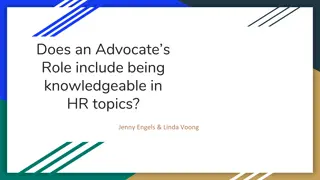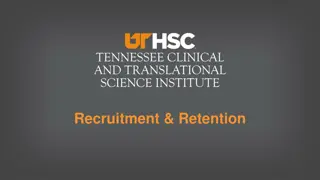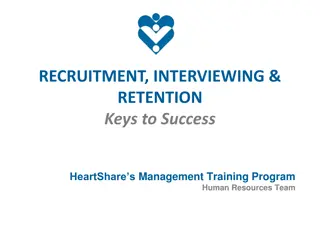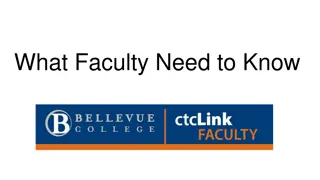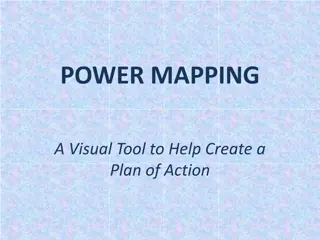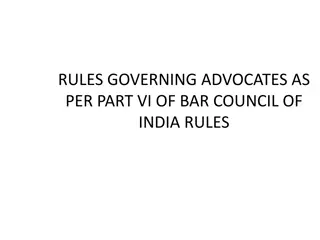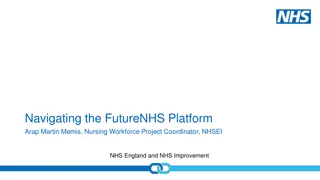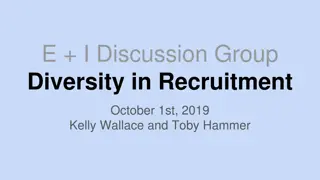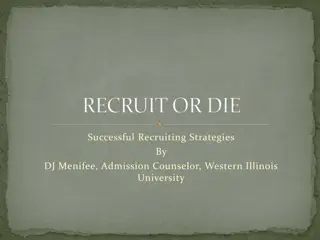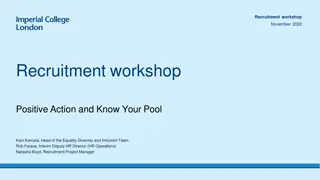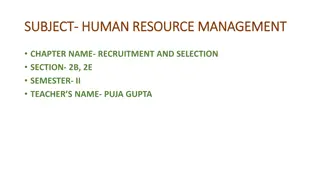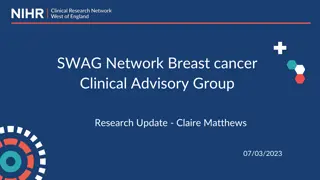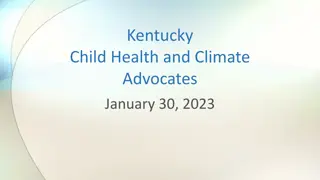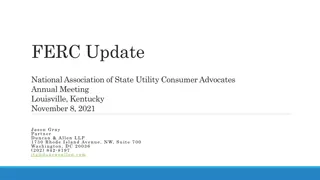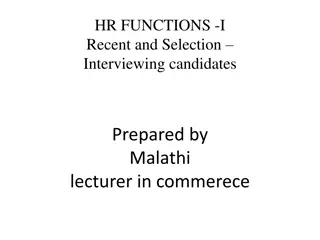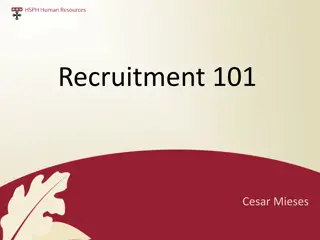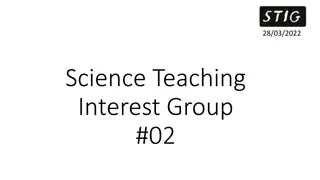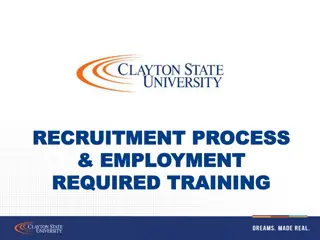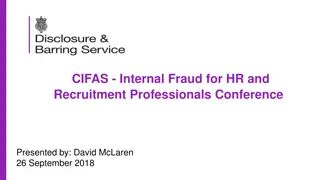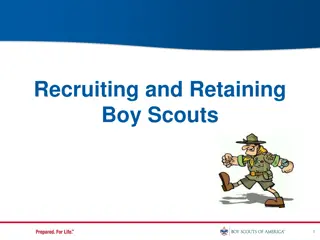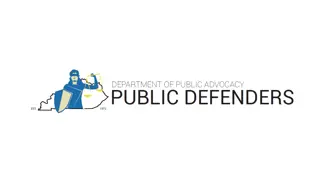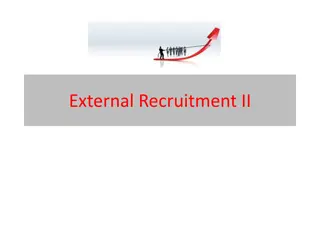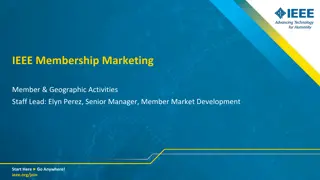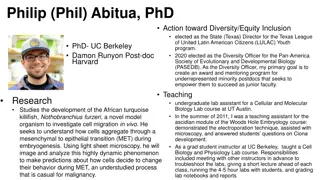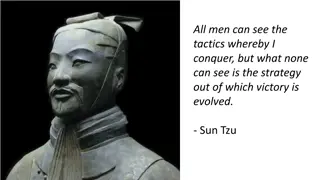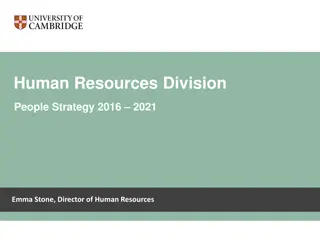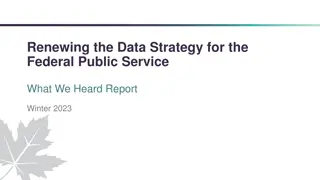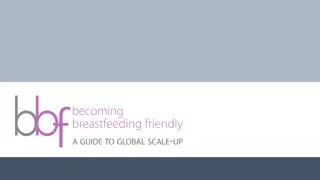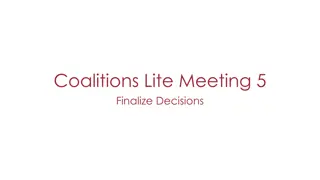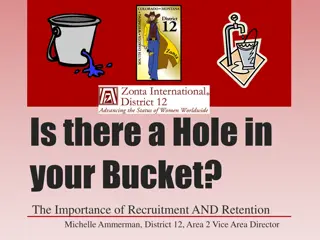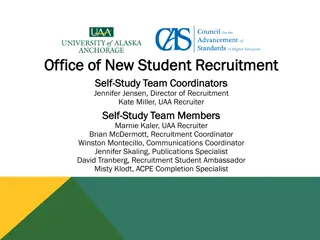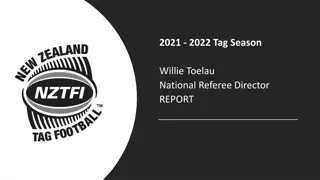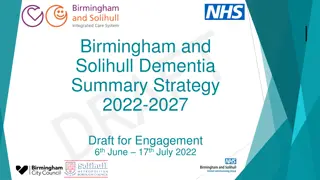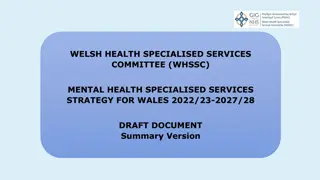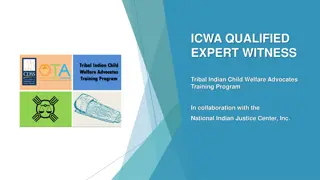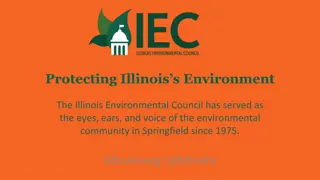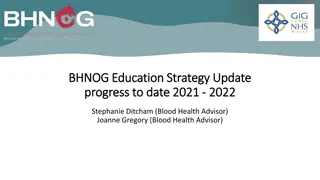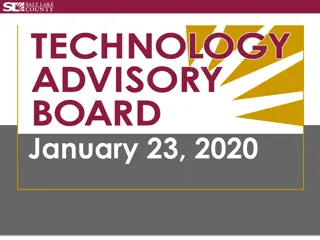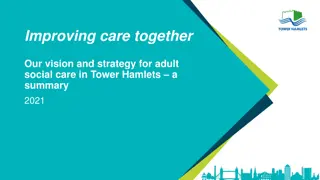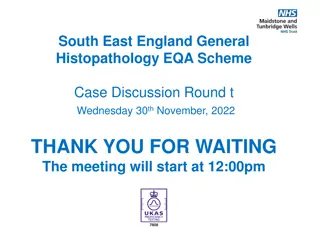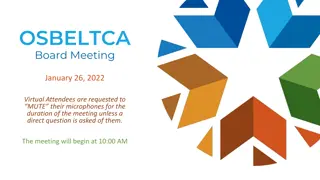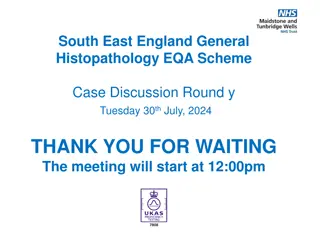EURORDIS Support to ePAG Advocates: Recruitment Strategy Meeting Overview May 2022
EURORDIS has shifted its focus to supporting ePAG advocates across various horizontal areas such as governance, research, and training. This includes the establishment of working groups like Training and Education, Research and Registries, and Compensation. The Recruitment Strategy for 2022-2023 involves analyzing current gaps in patient representation across European countries and ERNs to improve recruitment efforts. The methodology includes conducting gap analyses, renewing mandates, and sourcing information from various channels to enhance ePAG advocacy.
Download Presentation

Please find below an Image/Link to download the presentation.
The content on the website is provided AS IS for your information and personal use only. It may not be sold, licensed, or shared on other websites without obtaining consent from the author. Download presentation by click this link. If you encounter any issues during the download, it is possible that the publisher has removed the file from their server.
E N D
Presentation Transcript
EURORDIS Support to ePAG advocates and Recruitment Strategy Council of National Alliances Meeting May 2022
The change in EURORDIS approach to support PE in the ERNs EURORDIS has moved progressively from providing hands-on support to individual ePAG groups to supporting ePAG advocates via cross-ePAG groups focusingin horizontal areas, such as governance, development of clinical decision support tools and clinical practice guidelines, research, training, health data and evaluation 3
Overview of horizontal WGs 2 3 1 ePAG ePAG ePAG AMEQUIS Task Force Training and Education WG Research and Registries WG GulcinGumus/In s Hernando Matt Bolz-Johnson Lenja Wiehe 5 4 6 Ad-hoc sub- working groups when needed for example Compensation WG (ePAG leads + Lenja Wiehe) Connecting Patients with ERNs WG ePAG Steering Committee ePAG CPG WG In s Hernando Lenja Wiehe/In s Hernando Matt Bolz-Johnson 4
Recruitment Strategy 2022-2023 1. Analysis of current situation 2. Recruitment strategy 2022-2023
1. Analysis of current situation Methodology Aim: To identify country and/or disease gaps in the representation of patients. ERN-specific and global (24 ERNs) gap analysis were both conducted Renewal of mandate (existing pool) EURORDIS Contact database Information sources Discussions /feedback from ePAG leads and ERN project managers ERN websites ePAG gap analysis 7
2. Analysis of current situation -Country representation 48European countries were considered in our analysis (EURORDIS reference country list adapted from Council of Europe) 30(62.5 %) European countries have ePAGrepresentatives 50 47 45 43 43 39 40 35 The aim is not to recruit ePAG advocates from all 48 countries all but this was our basis to look at the gapsacross the 24 ePAGs. 31 N of ePAG advocates 29 30 25 20 17 Next step: Check how many of these POs are European Federations and consider the geographical scope in terms of representation in the analysis. Number of countries represented is bigger than this image shows. 4 4 3 2 2 2 15 10 10 8 7 7 6 5 5 2 2 1 1 1 1 1 1 1 1 0 8
3. Analysis of current situation -Country representation Number of ERNs with patient representation in the different countries 20 5 19 3 6 2 2 1 UK Germany Netherlands Italy France Spain Switzerland Ireland 15 2 1 16 11 15 2 5 1 13 7 Finland Belgium Portugal Sweden Romania Hungary Poland Denmark 6 1 1 2 4 1 Austria Bulgaria Ukraine Czech Republic Norway Latvia Macedonia Croatia 8 1 1 2 1 Slovenia Luxembourg Bosnia and Herzegovina Greece Cyprus Lithuania TRANSPLANT-CHILD ERN EYE PAEDCAN ERN BOND GENTURIS euROGEN ERNICA EuroBloodNet ERN RND EpiCARE ERN CRANIO RITA ERN SKIN GUARD HEART ReCONNET EURACAN ITHACA ENDO-ERN ERN LIVER ERN LUNG ERKNet METABERN VASCERN EURO NMD 0 5 10 15 20 25 30 35 40 9
4. Analysis of current situation -Country representation 18 (37.5%) European countries do not have ePAG representatives Eastern Europe Southern Europe Central Europe Northern Europe Other Albania Armenia Belarus Estonia Georgia Montenegro Republic of Moldova Russian Federation Serbia Slovakia Azerbaijan Andorra Malta San Marino Iceland Turkey Lichtenstein Monaco 10
5. Analysis of current situation Within each ERN we have done an analysis of gaps per disease area % of WG without ePAG advocates % of WG with only 1 ePAG advocate N of WG with 2 or more ePAG advocates Chronic Lung Allograft Disfunction (CLAD), Non-CF Bronchiectasis (NCFB) and Primary Cilary Dyskinesia (PCD) (ERN LUNG) Frontotemporal dementia (ERN RND) Ichthyosis & Palmoplantar Keratoderma, Mendelian Causes of Connective Tissue Disorders and ToxiTEN-Severe cutaneous drug reactions (ERN SKIN) Gastroenterological diseases, Intestinal failure and Abdominal wall defects (ERNICA) Anterior segment rare eye diseases (ERN EYE) Pediatric Rheumatic diseases (PR) (RITA) Rare cancer of the male genital organs and of the urinary tract (EURACAN) Rare bleeding-coagulation disorders and related diseases and Hemochromatosis and other rare genetic disorders of iron metabolism and heme synthesis (EuroBloodNet) 16 % 54 % 30 % 11 *EpiCARE, PAEDCAN and ERN BOND do not have disease WG, hence they were not included in this analysis
6. Analysis of current situation -Succession planning In terms of succession planning, we have assumed that those who joined the ePAGs in 2016/2017 might want to step down in the coming years (around 100 people). (220) Joined after 2017 (101) Joined 2016/2017 0 10 20 30 40 50 60 70 80 % of ePAG advocates 12
Based on these analysis, our recruitment strategy in 2022-2023 will aim at 1. Recruiting 50 - 60 ePAG advocates to cover gaps in specific ERNs. 2. Recruit at least 60-70 ePAG advocates to have a pool of people with expertise and knowledge to replace the ePAG advocates that might step down in the next few years. 3. Have at least 1 ePAG advocate from each country in each ERN even if represented through a European Federation In both cases, focus on candidates ideally coming from Eastern and Northern European countries 13
Any questions, suggestions or comments? Thank you for your attention!
1. Objectives and recruitment actions OBJECTIVES: To achieve sustainable patient representation and good coverage in terms of countries and disease areas ePAG leads, ERN project managers, Coordinators and clinicians National Alliances and European Federations (Anja Helm) EURORDIS Open Academy alumnae (Sharon/Marta) Rare2030 Young Citizens (Anna/Julien) EPF (Young Patient Advocates alumnae) Mobilise EURORDIS networks 1 Comms strategy To be defined with EURORDIS Comms team EURORDIS member news + social media postings ERNs newsletters 2 Follow-up actions 3 The whole process will be managed depending on the number of applications received. 16
2. Application stage Application process: Process, criteria and requirements described in the ePAG ToRs. If these are not updated, we will use the approach in EURORDIS ePAG ToRs template 1 New ePAG advocates Application package: Online application package including ePAG Factsheet + Short guide Thinking to become an ePAG advocate , application form, ERN and ePAG ToRs ERN Project Managers & ePAG leads with EURORDIS support 2 Timeline:Q3 2022-Q1 2023 3 17
Overall timeline (2022/23) Recruitment stage May to June EURORDIS to share gaps & basic information on ERNs with individual national alliances, European federations and with ERN clinicians and other partners so that they can reach out to potential candidates. Application processing stage June to December EURORDIS to contact the candidates and processing application forms working with ePAGleads and ERN project managers. Selection stage Dec to March 2023 ePAGleads & ERN coordination teams to select suitable candidates. Recruitment kick-start Comms campaign Recruitment finalised March 2023 May 2022 June December Presentation of recruitment outcome to Council of National Alliances and other partners MAY JUNE 23 June 12 May Presentation of recruitement startegy at the Council of National of National Alliances ePAG Steering Committee annual meeting Presentation of recruitment strategy and updates on porgress and activities Comms team (social media, other communication platforms) 18
Comments, suggestions are welcome! Thank you!
Mandate, membership and update Ad-hoc sub-group of the ePAG Steering Committee to work on governance aspects and templates that can be used across all ePAGs. The composition varies depending on the work that needs to be done and the availability and interests of ePAG leads/SC members. Jan-April 2021: Allison, Dalia, Johan, Simone, Astri, Marie Claude + In s 1. An updated template for ePAG Terms of Reference (ToR) 2. An online application form for ePAG advocates 3. A checklist to assess compliance with ePAG ToR EYE, GENTURIS and CRANIO ERN Coordinators approached EURORDIS to review their governance frameworks for patient engagement Oct-Nov 2021: Gareth Davies, Dominique Sturz + Olivia Spivack/CRANIO ERN PM and Doroth e Leroux/EYE ERN PM + In s 1. New template to include relevant sections on patient engagement in the ERN bylaws 2. New ePAG ToR template to ensure consistency with the new template for ERN bylaws 3. New template -Agreement between ERNs and PO that have designated an ePAG advocate 4. New template Supporting Partner template for individual patients and family members and patient organisations with no designated ePAG advocate in the ERN 20
#1-Two levels of patient engagement in the ERNs Individual patients and family members and SM- based support groups 1. Legally registered and operates in Europe (48 countries), representing patients and families living with a rare disease that belong to the scope of the ERN. This registration requirement can be waived in exceptional cases. 2. Has a governing board made up of a majority patients or of family members of patients. This requirement can be waived in exceptional cases. 3.Is financially independent, particularly from the pharmaceutical industry (max. 50% of funding from several companies). 4. Holds non-profit status. 5. Has proven activities such as patient support and/or advocacy activities and/or research. Patient Organisations registered outside Europe May be may be invited to collaborate with the ERN and the ePAG on specific tasks and projects Patient Organisations registered in Europe Patient Organisations that do not have a representative in the ePAG. They may be willing to collaborate on specific tasks (e.g. respond to surveys), help to disseminate information about the ERN, be kept informed on the development of the ERN activities Patient Organisations registered in Europe that have designated an ePAG advocate Supporting partners 21 Associate Partners
Associate Partners representatives (ePAG advocates) Application Process Applicant provides additional info to PM team and ePAG leads Patient organization signs agreement and sends it back to PM team Initiates Application Submits Applicant application form Including all accompanying documents Adds name to EURORDIS contact database Notifies applicant of rejection EURORDIS Receives application and sends to ERN PM team and ePAG leads End of the process End of the process Approval is through agreement in the ePAG and in consultation with ERN Coordinator Yes Reviews the skills & experience of candidate with all ePAG advocates Informs EURORDIS of the decision and grounds for rejection All OK? Requests additional info from applicant Missing info ePAG Leads All OK? Yes No No Yes ERN PM Team Adds ePAG advocate name to ERN website and notifies EURORDIS Notifies applicant and sends Associate Partnership Bilateral Agreement to PO Informs EURORDIS of the decision and grounds for rejection Checks whether the Patient Organization meets the requirements foreseen in the ERN bylaws/ToRs Requests additional info from applicant All OK? Missing info Yes All OK? No No


